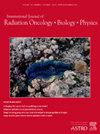基于纵向 CT 特征的食管癌患者局部无复发生存期预测模型:一项多中心研究
IF 6.4
1区 医学
Q1 ONCOLOGY
International Journal of Radiation Oncology Biology Physics
Pub Date : 2024-10-01
DOI:10.1016/j.ijrobp.2024.07.065
引用次数: 0
摘要
目的/目标:对于接受确定性化放疗(dCRT)的食管鳞状细胞癌(ESCC)患者来说,准确预测无局部复发生存期(LRFS)仍然是一项巨大的挑战。然而,整合纵向数据在提高预测能力方面具有巨大潜力。本研究旨在开发和验证一种深度学习模型,该模型结合了纵向CT扫描,可准确预测接受dCRT治疗的ESCC患者的LRFS.材料/方法我们回顾性地收集了321例在本院接受dCRT治疗的ESCC患者,并将其随机分为训练集(224例)和内部验证集(91例)。此外,我们还将其他三家肿瘤医院的 202 名患者分为两个外部验证集(111 名和 91 名)。利用患者在 dCRT 前后的计算机断层扫描(CT)图像。通过 LASSO-Cox 提取并选择了与 LRFS 相关的瘤内和瘤周放射学特征。随后,我们开发了一种相关性驱动的解脱生存网络(CDDSN),该网络集成了 ResNet 块、基变换器和基本 CNN,可有效融合纵向 CT 图像中的共享和独特深度特征。然后将选定的放射学特征和深度特征进行整合,建立了最终的 CDDSN 模型,并利用外部数据集对其性能进行了验证。此外,我们还在训练集中使用独立的临床因素和 CDDSN 特征开发了一个多模态提名图,随后在三个验证集中对其进行了测试。在训练集、内部测试集和两个外部验证集中,C 指数分别为 0.796(95% CI = 0.741-0.851)、0.738(95% CI = 0.675-0.801)、0.712(95% CI = 0.661-0.758)和 0.708(95% CI = 0.657-0.748)。此外,在每个数据集中,整合了瘤内和瘤周特征的 CDDSN 模型的表现均优于仅使用瘤内特征的模型。此外,在两个外部验证集中,与早期融合和晚期融合方法相比,我们的 CDDSN 模型在 LRFS 方面表现出更高的融合和预测能力(C 指数:分别为 0.712 vs 0.690 vs 0.681;0.708 vs 0.661 vs 0.684)。此外,多变量 Cox 回归分析显示,年龄、T 分期和淋巴细胞绝对计数与 LRFS 显著相关(P<0.05)。结合临床因素和 CDDSN 特征的多模态提名图对 LRFS 具有良好的预测能力,训练集的 C 指数为 0.826,验证集的 C 指数为 0.709-0.734。基于 CDDSN 的提名图为 ESCC 的个体化治疗决策提供了一种很有前景的方法。本文章由计算机程序翻译,如有差异,请以英文原文为准。
Longitudinal CT Feature-Based Model for Predicting Local Recurrence Free Survival in Esophageal Cancer Patients Treated with Definitive Chemoradiotherapy: A Multicenter Study
Purpose/Objective(s)
Accurate prediction of local recurrence-free survival (LRFS) remains a great challenge for esophageal squamous cell carcinoma (ESCC) patients receiving definitive chemoradiotherapy (dCRT). However, the integration of longitudinal data holds significant potential for improving predictive capabilities. This study aims to develop and validate a deep learning model that incorporates longitudinal CT scans to accurately predict LRFS in patients with ESCC following dCRT.
Materials/Methods
We retrospectively collected 321 ESCC patients who underwent dCRT at our hospital and randomly divided them into training set (224) and internal validation set (91). Additionally, 202 patients from three other cancer hospitals were divided into two external validation sets (111 and 91 patients). The patients’ computed tomography (CT) images before and after dCRT were utilized. LRFS-related intratumoral and peritumoral radiomic features were extracted and selected through LASSO-Cox. Subsequently, we developed a correlation-driven disentanglement survival network (CDDSN), which integrated a ResNet block, base transformer, and basic CNN to effectively fuse shared and unique deep features from longitudinal CT images. The selected radiomic and deep features were then integrated to establish the final CDDSN model, the performance of which was validated using external sets. Furthermore, we developed a multimodal nomogram using independent clinical factors and the CDDSN signature in the training set, which was subsequently tested in three validation sets.
Results
Compared to the models utilizing CT images acquired before or after dCRT, the CDDSN model based on longitudinal CT scans achieved the highest performance in LRFS predictive with the C-index of 0.796 (95% CI = 0.741-0.851), 0.738 (95% CI = 0.675-0.801), 0.712 (95% CI = 0.661-0.758) and 0.708 (95% CI = 0.657-0.748) in the training set, internal testing set and the two external validation sets, respectively. Moreover, the CDDSN model integrating both intratumoral and peritumoral features outperformed the model solely using intratumoral features in each dataset. Additionally, our CDDSN model demonstrated superior fusion and predictive power in LRFS compared to the early fusion and late fusion methods in the two external validation sets (C-index: 0.712 vs 0.690 vs 0.681; 0.708 vs 0.661 vs 0.684), respectively. Furthermore, multivariable Cox regression analysis revealed that age, T stage, and absolute lymphocyte count were significantly correlated with LRFS (P<0.05). The multimodal nomogram, incorporating clinical factors and the CDDSN signature, exhibited a favorable predictive power for LRFS with a C-index of 0.826 in the training set and 0.709-0.734 in the validation sets.
Conclusion
The CDDSN model, utilizing longitudinal CT images, can enhance the predictive power for LRFS in patients with ESCC following dCRT. The CDDSN-based nomogram may offer a promising approach for helping ESCC individualized treatment decisions.
求助全文
通过发布文献求助,成功后即可免费获取论文全文。
去求助
来源期刊
CiteScore
11.00
自引率
7.10%
发文量
2538
审稿时长
6.6 weeks
期刊介绍:
International Journal of Radiation Oncology • Biology • Physics (IJROBP), known in the field as the Red Journal, publishes original laboratory and clinical investigations related to radiation oncology, radiation biology, medical physics, and both education and health policy as it relates to the field.
This journal has a particular interest in original contributions of the following types: prospective clinical trials, outcomes research, and large database interrogation. In addition, it seeks reports of high-impact innovations in single or combined modality treatment, tumor sensitization, normal tissue protection (including both precision avoidance and pharmacologic means), brachytherapy, particle irradiation, and cancer imaging. Technical advances related to dosimetry and conformal radiation treatment planning are of interest, as are basic science studies investigating tumor physiology and the molecular biology underlying cancer and normal tissue radiation response.

 求助内容:
求助内容: 应助结果提醒方式:
应助结果提醒方式:


